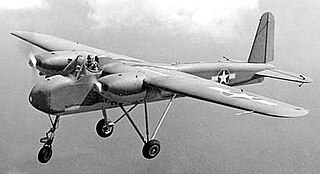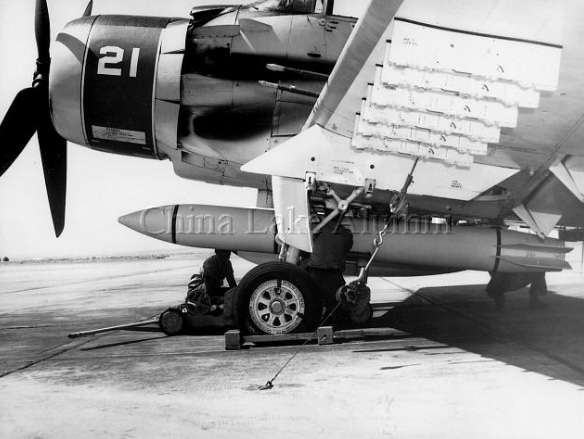Ping-Pong was a battlefield reconnaissance rocket developed by Lockheed-California – later the Lockheed Missiles and Space Company – for use by the United States Army. Intended to give battlefield commanders the ability to gain photographic data on enemy locations, it reached the flight-test stage before being cancelled.
The W42 was an American nuclear fission weapon developed in 1957.

The VB-6 Felix was a precision-guided munition developed by the United States during World War II.

The LBD-1 Gargoyle was an American air-to-surface missile developed during World War II by McDonnell Aircraft for the United States Navy. One of the precursors of modern anti-ship missiles, it was extensively used as a test vehicle during the late 1940s.

The Interstate XBDR was a design for an assault drone - an early television-guided missile - powered by two jet engines, that was designed by the Interstate Aircraft and Engineering Corporation during the latter stages of the Second World War for use by the United States Navy. Wind tunnel tests of a scale model were conducted, however no full-scale examples of the aircraft were built before the project was cancelled.

The Naval Aircraft Factory TDN was an early unmanned combat aerial vehicle - referred to at the time as an "assault drone" - developed by the United States Navy's Naval Aircraft Factory during the Second World War. Developed and tested during 1942 and 1943, the design proved moderately successful, but development of improved drones saw the TDN-1 relegated to second-line duties, and none were used in operational service.

The Bold Orion missile, also known as Weapons System 199B (WS-199B), was a prototype air-launched ballistic missile (ALBM) developed by Martin Aircraft during the 1950s. Developed in both one- and two-stage designs, the missile was moderately successful in testing, and helped pave the way for development of the GAM-87 Skybolt ALBM. In addition, the Bold Orion was used in early anti-satellite weapons testing, performing the first interception of a satellite by a missile.

The Hopi was an air-to-surface missile developed by the United States Navy's Naval Ordnance Test Station. Intended to provide a medium-range nuclear capability for carrier aircraft, the missile reached the flight test stage during 1958, but the project was cancelled following testing and no production was undertaken.
The Wagtail missile, also known as "Wag Tail", was a short-range nuclear missile developed in the late 1950s by Minneapolis-Honeywell under a contract awarded by the United States Air Force. Intended for use as an auxiliary weapon by bomber aircraft, the missile was successfully test fired in 1958, but the program was cancelled in the early 1960s.

The Advanced Strategic Air-Launched Missile (ASALM) was a medium-range strategic missile program, developed in the late 1970s for the United States Air Force. Intended for use in both the air-to-surface and anti-AWACS roles, the missile's development reached the stage of propulsion-system tests before being cancelled in 1980.
The Diamondback was a proposed nuclear-armed air-to-air missile studied by the United States Navy's Naval Ordnance Test Station during the 1950s. Intended as an enlarged, nuclear-armed version of the successful Sidewinder missile, Diamondback did not progress beyond the study stage.

The Creative Research On Weapons or Crow program was an experimental missile project developed by the United States Navy's Naval Air Missile Test Center during the late 1950s. Intended to evaluate the solid-fueled integral rocket/ramjet (SFIRR) method of propulsion as well as solid-fueled ramjet engines, flight tests were conducted during the early 1960s with mixed success.

The AAM-A-1 Firebird was an early American air-to-air missile, developed by the Ryan Aeronautical Company. The first air-to-air missile program developed for the United States Air Force, the Firebird was extensively tested in the late 1940s; although it proved successful in testing, it was soon obsolete due to the rapid advances in aircraft and missile technology at the time and did not enter production.

The AAM-N-4 Oriole was an early American air-to-air missile, developed by the Glenn L. Martin Company for the United States Navy. Designed for launch from carrier-based aircraft, the missile programme was cancelled before flight testing began, and the missiles produced were utilized as test vehicles.

The AAM-N-5 Meteor was an early American air-to-air missile, developed by the Massachusetts Institute of Technology and Bell Aircraft for the United States Navy. Designed for launch from carrier-based aircraft, the program proceeded to the flight testing stage before being cancelled.

The Radioplane XKD4R, known by the company designation RP-70, was an American target drone developed by the Radioplane Division of the Northrop Corporation. Although it was not produced in quantity, it was developed into the successful AQM-38.

The KA2N Gorgon IIA – also designated KU2N, CTV-4, and CTV-N-4 – was an air-to-air missile developed by the United States Navy near the end of World War II. Proving a failure in its designed role, it was repurposed as an experimental testbed for missile technology.

The Gorgon III – given the military designations KA3N, KU3N, CTV-N-6 and RTV-N-4 – was a rocket-powered air-to-air missile developed by the United States Navy near the end of World War II. With the end of the war, the program was changed to that of a research vehicle for missile control systems; both single and twin-rocket-powered versions were built and tested.

The XSSM-A-23 Dart was an anti-tank guided missile developed for the United States Army in the 1950s. After protracted development, the missile, similar in design to the French SS.10, was cancelled in favor of purchasing the SS.11 missile.

Skokie was a family of research vehicles developed by the Cook Electric Co. for the United States Air Force during the mid to late 1950s. Launched from a B-29 bomber, Skokie 1 was an unpowered, ballistic vehicle, while Skokie 2 was rocket-propelled; both were used for evaluating and testing high-speed parachute recovery systems.

















